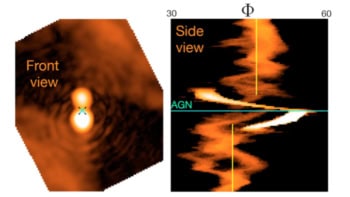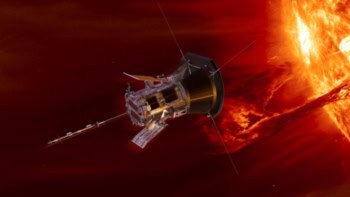
Physicists in the US and Singapore are the first to use light from distant galaxies to perform a systematic search for cosmic strings — massive structures that may have been created just after the Big Bang. Although the team has found no evidence of cosmic strings in the small patch of sky they surveyed, they have been able to set an upper limit on the mass per unit length of the strings. The team is now working to improve their results by looking at larger patches of the sky.
Cosmic strings are extremely long and dense structures that many physicists believe were created about 10-35 s after the Big Bang. At this time the universe became cool enough for the electrostrong force to begin to separate out into the strong and electroweak forces. This “symmetry breaking” process marked a phase transition in the state of the universe — something akin liquid water freezing to ice.
Just as crystal defects occur when water freezes, some cosmologists believe that defects in the fabric of the universe in the form of cosmic strings emerged during this phase transition. These extremely massive 1D objects could endure to this day — and studying them could provide important information about the early universe and how stars and galaxies evolved from the primordial fireball.
Lack of evidence
The only problem is that no-one has managed to find any compelling evidence for the existence of cosmic stings. The best that researchers have done so far is to put an upper limit on the density of cosmic strings. So far, this has been done by looking for their effects on the cosmic microwave background (CMB); searching for gravitational waves created when a cosmic string cracks like a whip; and looking for evidence of gravitational lensing, whereby light from a distant galaxy is bent by the strong gravitational field of a cosmic string, making a single galaxy appear as a pair of galaxies to an observer on Earth.
Now, however, a team of researchers in the US and Singapore has performed the first systematic search of a section of the sky to look for evidence of gravitational lensing by cosmic strings. The team used a survey of about 300 square arcminutes of the sky — about one millionth of the universe — obtained by the Hubble space telescope.
The survey contains about 78,000 galaxies, and the team used a computer algorithm to sift through all these images to look for nearby pairs of galaxies that may actually be a single galaxy seen through the gravitational lens of a cosmic string (Phys Rev D 77 123509).
Jodi Christiansen and colleagues at California Polytechnic State University, the University of California, Berkeley and the National University of Singapore began by cataloging the position, shape and brightness of all 78,000 individual galaxies above a certain brightness threshold. The team then searched the catalogue for “pairs” of galaxies of similar size and brightness that were separated by less than 15 arcseconds, finding about 6600 pairs that satisfied these criteria.
Background level
Computer simulations of how a cosmic string would bend the light from distant galaxies suggested that lensed galaxy pairs would be separated by 6 arcseconds or less. As a result, Christiansen and colleagues assumed that the pairs separated by 7–15 arcminutes give a measure of the background level of pairs that appeared by chance, rather than as a result of cosmic-string-induced gravitational lensing.
While the analysis failed to find a significant excess of pairs that could be attributed to the presence of cosmic strings, the team was able to put an upper limit on the mass of cosmic strings — they must be less than about 2% of the total mass of the universe. In terms of a mass per unit length for individual cosmic strings, the upper limit is about 10-7 in dimensionless units.
This is better than a limit (about 10-6) imposed by a recent search by team-member and Nobel prize-winner George Smoot, who looked for temperature fluctuations in the CMB that could be caused by cosmic strings. However, it is not as precise as limits derived from an analysis of the CMB power spectrum and the search for gravitational waves produced by cosmic strings (about 10-8).
However, Christiansen points out that the power-spectrum and gravitational-wave searches are dependent upon several assumptions regarding how cosmic strings move through the universe, which makes them potentially more difficult to interpret that gravitational lens results.
One drawback with the current survey is that it only covers a very small patch of the universe. Christiansen says that the team is now working to improve precision of the technique by using a more recent survey of the sky called COSMOS, which looks at a much larger patch of the sky measuring two square degrees.



